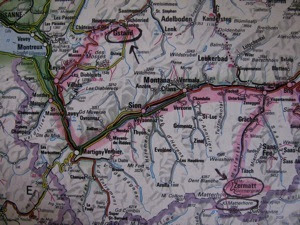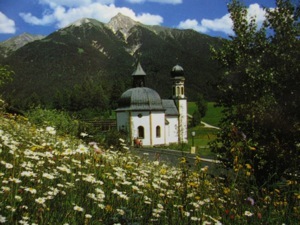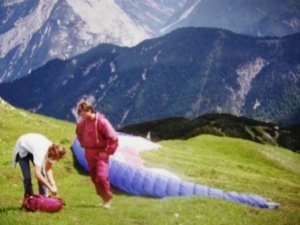After our last look at Lake Maggiore, we said goodbye to our great GCT guide Tony. Now Leila became our full-time tour guide. We boarded our tour bus for the nine hour transfer to Gstaad, Switzerland Custom officials were posted at the border, but there was no hassle.
We encountered magnificent scenery on our journey to the Simplon Pass, the only way through the Alps here (7,000 foot altitude). Napoleon demanded a low-altitude pass for his artillery, and the present road follows the 1805 plan designs.
First we had to leave our bus to take a train ride for the last stretch. Gushing mountain streams provided great scenery.
The town was charming. We ate our lunch at the rail station Bahnhof buffet before starting our stroll of the town. We appreciated that Zermatt was a vehicle free resort.
The train ride back to our tour bus offered more outstanding scenery. Then we were back on the highway to Aigle, From here our bus had to climb winding roads to Gstaad.
We were impressed as we approached our Grand Hotel Bellevue (pictured right). Our host served welcome drinks in the lounge area.
June 30, Friday
After breakfast we looked over the Grand Hotel Bellevue. Then our GCT guide Liela took us for a walking tour through the quaint city center. At the other end of town was a unique hotel resembling a castle. The Gstaad Palace was the favorite spot for famous people around the world including Grace Kelly, Audrey Hepburn, Elizabeth Taylor, John Kenneth Galbreaith, Paris Hilton, Michael Jackson. Prince Charles....
In the center of town was fountain with a sculpture of a drinking animal at a trough. This life size bronze calf had been designed by Elizabeth Taylor’s daughter. Donors listed on a plaque included Elizabeth Taylor.
During the afternoon we undertook an included excursion to the charming rural villages of the Saaneland. Our bus stopped for “A Taste of Switzerland” tour in the village of L’Etivaz.
The first circular pieces of cheese we saw were from those brought in from the higher elevation summer pastures. The second area contained cheese that was 3 months old. At this site a worker was busy loading shelves. At the conclusion of the tour, we sampled cheese with wine and bread. Some of the cheese had been aged for three years.
From here our driver proceeded to the beautiful country town of Rougemont (pictured on right) The Romanesque church had a central location in the community of 900.
The figures in the stained glass appeared to be the reformers Calvin and Zwingli.
July 1, 2000
All four of us elected to take the $69 optional tour to Lake Geneva and the Swiss Riviera. I traced the day long journey on a map.
When the train pulled up to the Gstaad railway station we looked for the Pullman car that had been reserved for our GCT group. Sitting back in comfort, we travelled though the Bernese highlands from Gstaad to Montreux (see map above).
Our waiting bus driver took us from the train station to Vevey (pronounced Vee vay’),a favorite haunt of Charlie Chaplin. The Chaplin statue on the waterfront provided a nice photo shot for our quartet.
We ambled along cobble stones to the Old Town (Altstadt) where we were entertained by Alp horn players.
There were performers everywhere. A band concert caught our attention and we relaxed to some beautiful music.
Reluctantly, we left the fun-filled center and moved on to our next site. But this was equally as satisfying -- a tour of the Castle of Chillonthat overlooked the lake. Lord Byron's famous poem, The Prisoner of Chillon, was about a real person: Francis Bonivard, a lay official at St. Victor's priory in Geneva, who spoke out in favor of the Reformation and was shackled to a stone pillar by the Duke of Savoy from 1530 until the Bernese conquest of Vaud in 1536.
The self guided tour was great. We could explore the banquet halls, battlements, basement (right) and roam the walkways.
The included lunch of vegetable quiche was held in a romantic restaurant called Taverne of the Castle of Chillon.
The last stop of the day was at the historic town of Aigle which featured the Castle and Wine Museum. The Bernese burnt the original 13th century place to the ground in 1475, rebuilding and redesigning it to serve both a defensive function on the fringes of Bernese power and as a residence for the installed bailiffs.
July 2, Sunday
Today was a free on-your-own day. Irma and Mike used the time for walking along the Yehudi Menuhin Philosophenweg Path along the River Saanen. Annette and Fred chose to take a train to Bern (via Spiez, where we changed trains). See map on right. Bern is the capital of Switzerland. The population of the canton is predominantly Protestant and German-speaking. Bern accepted the Reformation 1528. The well preserved Old Town that we will visit was granted World Cultural Heritage status by UNESCO.
We walked out into the Bahnofplatz from the train station. We started out at the bottom of the map in the pink area, then followed the left pink line up to the river and returned via the pink route on the right.
As we crossed the Aare River via the Nydeggbrucke, I video-taped the red roofed buildings that lined the river.
Our objective on the east bank was the Bear Pits or Barengrabben which date to the 15th century. Whatever be the real connection of the words 'bear' and 'Bern,' the figure of a bear occurs in the oldest known city seal (1224), and living bears have been kept in Bern at the town's expense since 1513 (except for a brief interval when the French removed them to Paris in 1798).
On March 11, 1421, Matthäus Ensinger began construction on a monumental new cathedral to take the place of the original chapel. Work continued on the Münster, using local sandstone, for over a century. It was not fully completed until 1893, when the bell tower was added. In the meantime, Bern had become Protestant and the Berner Dom became the Berner Münster (collegiate church).
The most exceptional feature of Bern's Münster is the magnificent depiction of the Last Judgment over the main portal, which contains more than 200 carved wood and stone figures. Such a large collection of late-Gothic sculpture is a rare survival in Europe.
While Annette and I were seated in the church, a large group of men and women entered the church, sat down in the pews and began singing hymns in German. This made the visit even more meaningful.
From here we walked over to the Parliament Building. The Swiss parliament and government building, the Bundeshaus, with its imposing green dome, stands high above the Aare River. It has become so much of a land-mark that it is hard to imagine what the city skyline looked like before it was there. But the building was only completed in 1902.
And here we are back to the Train Station. The church building on the left is the Holy Spirit Church (Protestant). When we arrived at Bern earlier, we listened to a Salvation Army Band and Choir. Their spirited music prompted the gathered crowd to clap hands to the music, We had the best day of the trip in Bern! Content, Annette and I boarded the train back to Gstaad and our comfortable hotel.
July 3, Monday
All four of us signed up for the $79 optional excursion of the Bernese Oberland (map) which passes by the lakes of Thun and Brienz and into the Lauterbrunnen Valley.
We visited the Trummelbach Falls near Grindelwald, a very rewarding experience. Here a waterfall (wasseorfalle) formed inside a mountain. The lower level was accessible by taking a foot path, but to reach the innermost parts of the fall, an elevator was necessary.
Trummelbach Falls is fed by the glacial runoff from three peaks-Eiger, Monk and Jungfrau and carries up to 20,000 liters of water per second.
For an excellent video, see http://vids.myspace.com/index.cfm? fuseaction=vids.individual&VideoID=58608772
The walkway tunneled around the falls with occasional outlooks to catch the majesty of roaring water.
After leaving this natural wonder, we headed for scenic forty minute train ride past cows grazing in the upper pastures.
After the descent on the railway, we visited Interlacken where we walked along the main drag “Hoheweg.”
This completed a full day and we returned to the hotel for a nice evening meal while the piano player provided background music.
July 4, Tuesday, Independence Day
After breakfast we were treated to an Alp Horn demonstration in the lounge, followed by an introduction to decoupage (paper cutting), one of the traditional crafts of the Saaneland.
Since this was a free day, Annette and Fred walked along the Yehudi Menuhin Philosophenweg trail to Saanen. The Saanen River with its rapidly flowing water was picturesque.
Fondue dinner was slated for our evening meal at one of the oldest restaurants in Switzerland. The dwelling had been a 300 year-old monastery. Many famous people had visited here, including Julie Andrews. The Swiss entertainment was provided for by a talented accordion player who also had a knack for yodeling.
Back at the hotel we began packing for the next days departure toward Austria.
July 5, Wednesday
After a nice ample breakfast at our hotel, we boarded the bus. On our journey eastward we had views of Griswel, Cograil of Pilatus (near Luzerne). Lake Zurich and Burgoppelm Castle.
After crossing the River Rhine near an old wooden bridge, our bus stopped at Vaduz, the capital of Liechtenstein. The country of Liechtenstein is the size of Manhattan with a population of 31,000 people, It is one of the last vestiges of Holy Roman Empire. We took an on your own walking tour of Vaduz.
After purchasing postage stamps we visited the St. Florian Cathedral. The preaching of Zwingli and Calvin converted the diocese.
Bishop Thomas Planta, a friend of St. Charles Borromeo, tried, but without success, to suppress Protestantism. For several years a bloody war was waged between the Catholics and the Protestants. Finally, the newly erected Congregation of Propaganda commissioned the Capuchins to save the Catholic faith' among the people in 1651.
We met back at the bus to continue our journey.
GO ON TO 2000 ALPINE TOUR III: AUSTRIA































































No comments:
Post a Comment